
   |
THE PRESENT NAME OF CLUJ-NAPOCA
was established on October 16th 1974, on the occasion of the celebration
of the first documentary attestation of the city as a “municipium",
1850 years ago. The name derives from the ancient Dacian name Napuca and
Cluj (clusa-clausa, meaning a narrow, confined place). Yet the first certified
documentary attestation dates from 1275, as villa Kluswar.
 2nd century - Ptolemy mentioned in his writings the Dacian village
under the name of Napuca. The Romans kept the name after the conquest
of Dacia (105-106). In the time of Hadrian the city became the capital
city of the new province under the name Municipium Aelium Hadrianum Napocense.
Later, it became a colony under Aurelius (161-180).
2nd century - Ptolemy mentioned in his writings the Dacian village
under the name of Napuca. The Romans kept the name after the conquest
of Dacia (105-106). In the time of Hadrian the city became the capital
city of the new province under the name Municipium Aelium Hadrianum Napocense.
Later, it became a colony under Aurelius (161-180).
 Middle of the 3rd century - After the Romans abandoned the city,
the population continued to live here. As a testimony, the excavations
in the Central “Unirii” Square, which are planned be preserved.
The centuries that followed were very difficult for the population, as
the Ostrogoth and the Gepids invasions plundered the city.
Middle of the 3rd century - After the Romans abandoned the city,
the population continued to live here. As a testimony, the excavations
in the Central “Unirii” Square, which are planned be preserved.
The centuries that followed were very difficult for the population, as
the Ostrogoth and the Gepids invasions plundered the city.
 The 9th and 10th century - The first fortified cities of Cluj and
Dabaca were part of Gelu’s viovodate (a primitive form of state),
which did not resist the pressure of the Hungarian invaders who conquer
it.
The 9th and 10th century - The first fortified cities of Cluj and
Dabaca were part of Gelu’s viovodate (a primitive form of state),
which did not resist the pressure of the Hungarian invaders who conquer
it.
 1241 -Tatar invasion plundered the city and destroyed its fortifications,
yet the city recovered and attracted many Saxons who settled in the city.
1241 -Tatar invasion plundered the city and destroyed its fortifications,
yet the city recovered and attracted many Saxons who settled in the city.
 August 9th 1317 - King Carol Robert made the settlement a city,
which triggered the economic flourishing of the settlement. Cluj established
many trade contacts with the other Romanian Principalities, as well as
with many European countries.
August 9th 1317 - King Carol Robert made the settlement a city,
which triggered the economic flourishing of the settlement. Cluj established
many trade contacts with the other Romanian Principalities, as well as
with many European countries.
 1437 - The Bobalna uprising - the poor inhabitants of the city
fraternized with the rioters. Consequently, the city lost some of its
economic privileges, which were restored under the rule of Iancu de Hunedoara.
1437 - The Bobalna uprising - the poor inhabitants of the city
fraternized with the rioters. Consequently, the city lost some of its
economic privileges, which were restored under the rule of Iancu de Hunedoara.
 1475 - The Tailors’ Bulwark was constructed as part of a larger
system of fortifications. The economic thriving made it possible for the
numerous guilds to contribute to an improved and extended system of fortifications
which spanned 45 hectars. The city of Cluj owed its development to a great
extent to the privileges bestowed upon it by Iancu de Hunedoara and his
son, Matei Corvin, kings of Hungary of Romanian origin.
1475 - The Tailors’ Bulwark was constructed as part of a larger
system of fortifications. The economic thriving made it possible for the
numerous guilds to contribute to an improved and extended system of fortifications
which spanned 45 hectars. The city of Cluj owed its development to a great
extent to the privileges bestowed upon it by Iancu de Hunedoara and his
son, Matei Corvin, kings of Hungary of Romanian origin.
 1541 - The Otomans conquered the Hungarian Kingdom and divided
it with Austria, the city continued to prosper as Transylvania became
an autonomous principality. The first printing house dated from this period,
many stone buildings
1541 - The Otomans conquered the Hungarian Kingdom and divided
it with Austria, the city continued to prosper as Transylvania became
an autonomous principality. The first printing house dated from this period,
many stone buildings
were built, as well as many schools and a University.
 1600 - Michael The Brave, ruler of Moldavia and Wallachia and forger
of the Union of the two with Transylvania, entered Cluj after the battle
of Miraslau. The rulers of the city revenged the defeat later, by burning
at the stakes one of the bravest captains in Michael’s army, Baba
Novac, whose body was displayed outside the city, near the Tailors’
Bulwark. A statue was erected there in his memory, in 1976.
1600 - Michael The Brave, ruler of Moldavia and Wallachia and forger
of the Union of the two with Transylvania, entered Cluj after the battle
of Miraslau. The rulers of the city revenged the defeat later, by burning
at the stakes one of the bravest captains in Michael’s army, Baba
Novac, whose body was displayed outside the city, near the Tailors’
Bulwark. A statue was erected there in his memory, in 1976.
 1738-1739 - The plague devastated the town, killing more than 10%
of the population.
1738-1739 - The plague devastated the town, killing more than 10%
of the population.
 The second half of the 17th century - The economic situation of
the city deteriorated and it lost its autonomy. The city entered under
Austrian rule and was forced to host the Austrian garrison.
The second half of the 17th century - The economic situation of
the city deteriorated and it lost its autonomy. The city entered under
Austrian rule and was forced to host the Austrian garrison.
 1790 - Cluj became the siege of the Hungarian Governors, reinforcing
its political authority, and the capital city of the Ardeal province.
The same year, the first Romanian Orthodox Church was built in Cluj, followed
by a Greek catholic one (1803), as the number of the Romanians who were
allowed to live in the city grew considerably.
1790 - Cluj became the siege of the Hungarian Governors, reinforcing
its political authority, and the capital city of the Ardeal province.
The same year, the first Romanian Orthodox Church was built in Cluj, followed
by a Greek catholic one (1803), as the number of the Romanians who were
allowed to live in the city grew considerably.
 1791 - The issuing of The Supplex Libellus Valachorum reinforced
the political status of the Romanians.
1791 - The issuing of The Supplex Libellus Valachorum reinforced
the political status of the Romanians.
 1848 - The Revolution which spread in the whole Austro-Hungarian
Empire involved many Romanians who had studied in Cluj, in the university
that functioned here.
1848 - The Revolution which spread in the whole Austro-Hungarian
Empire involved many Romanians who had studied in Cluj, in the university
that functioned here.
 1892-1894 - The Memorandist Movement was though the climax of the
assertion of the Romanians as a distinct and deign nation. The process
which followed in 1894 condemned the heads of the movement.
1892-1894 - The Memorandist Movement was though the climax of the
assertion of the Romanians as a distinct and deign nation. The process
which followed in 1894 condemned the heads of the movement.
 The 19th century - The economical development of the city continued.
Many factories and a the construction of a railway (1870) resulted in
an impressive development of the commerce. In 1872 a university was built,
as well as another building of the Theatre (1906).
The 19th century - The economical development of the city continued.
Many factories and a the construction of a railway (1870) resulted in
an impressive development of the commerce. In 1872 a university was built,
as well as another building of the Theatre (1906).
 1914-1918 - Many Romanians from Transylvania were forced to fight
against their Romanian brothers from the Kingdom of Romania or ended in
prisons or killed. Cluj was liberated and Transylvania became part of
the larger Kingdom of Romania, after the Union on the 1st of December
1918.
1914-1918 - Many Romanians from Transylvania were forced to fight
against their Romanian brothers from the Kingdom of Romania or ended in
prisons or killed. Cluj was liberated and Transylvania became part of
the larger Kingdom of Romania, after the Union on the 1st of December
1918.
 November 3rd 1919 - The Romanian University was inauguated in Cluj.
The town flourished between two wars: many schools, churches, museums,
institutes and theatres were built, integrating the life of the city into
the one of Greater Romania.
November 3rd 1919 - The Romanian University was inauguated in Cluj.
The town flourished between two wars: many schools, churches, museums,
institutes and theatres were built, integrating the life of the city into
the one of Greater Romania.
 August 30th 1940 - The Vienna Diktat imposed onto Romania to give
over a part of its territory, including Cluj. Many institutions were forced
to withdraw to other towns in Romania.
August 30th 1940 - The Vienna Diktat imposed onto Romania to give
over a part of its territory, including Cluj. Many institutions were forced
to withdraw to other towns in Romania.
 October 11th 1944 - Cluj was liberated from the German occupation,
and passed into Russian administration.
October 11th 1944 - Cluj was liberated from the German occupation,
and passed into Russian administration.
 March 13th 1945 - The part of Transylvania which was under Russian
military rule was rendered to the Kingdom of Romania.
March 13th 1945 - The part of Transylvania which was under Russian
military rule was rendered to the Kingdom of Romania.
 June 11th 1948 - 32 factories, many hospitals and cinemas entered
state property, as well as other important establishments.
June 11th 1948 - 32 factories, many hospitals and cinemas entered
state property, as well as other important establishments.
 October 1st 1948 - The Greek Catholics were forced to adhere to
Orthodoxy and many were imprisoned. Shortly, the rest of the religions
were banned and the churches were confiscated. Many personalities belonging
to a wide rage of activities were either forced to take a back seat, or
were imprisoned for their beliefs, while the fighters in the mountains
tried to resist the communist expansion.
October 1st 1948 - The Greek Catholics were forced to adhere to
Orthodoxy and many were imprisoned. Shortly, the rest of the religions
were banned and the churches were confiscated. Many personalities belonging
to a wide rage of activities were either forced to take a back seat, or
were imprisoned for their beliefs, while the fighters in the mountains
tried to resist the communist expansion.
The communist period was as devastating in Cluj as it was for the whole country. The city suffered, even more than other cities, from the Communist repression.
 1959 - The “Babes-Bolyai” University was established,
after the union of the “Babes” and “Bolyai” Universities.
The University had 10 faculties in 1974.
1959 - The “Babes-Bolyai” University was established,
after the union of the “Babes” and “Bolyai” Universities.
The University had 10 faculties in 1974.
 1968 - The city of Cluj became the political center of the Cluj
District. In the following years, many factories were built, as well as
many blocks of apartments. The city maintained its position as the second
most important cultural and scientific center of the country.
1968 - The city of Cluj became the political center of the Cluj
District. In the following years, many factories were built, as well as
many blocks of apartments. The city maintained its position as the second
most important cultural and scientific center of the country.
 December 21st 1989 - The revolution burst out in Cluj. Eleven people
were killed in the “Liberty” Square (today’s Piata Unirii)
and other 4 in front of Astoria Hotel. In the evening of the same day,
other 4 people were killed at the Beer Factory, followed by 3 in other
places of the town. The following years were the years of the consolidation
of democracy, of many economic, political, social and cultural transformations,
re-shaping the face of the city.
December 21st 1989 - The revolution burst out in Cluj. Eleven people
were killed in the “Liberty” Square (today’s Piata Unirii)
and other 4 in front of Astoria Hotel. In the evening of the same day,
other 4 people were killed at the Beer Factory, followed by 3 in other
places of the town. The following years were the years of the consolidation
of democracy, of many economic, political, social and cultural transformations,
re-shaping the face of the city.
were built, as well as many schools and a University.
The communist period was as devastating in Cluj as it was for the whole country. The city suffered, even more than other cities, from the Communist repression.
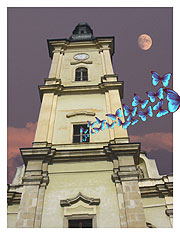 |
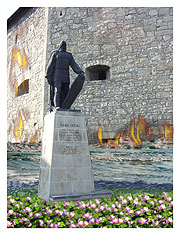 |
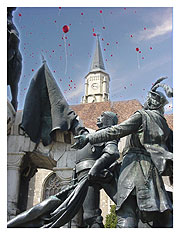 |
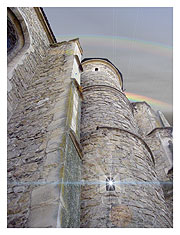 |
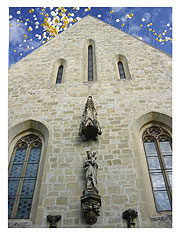 |
|
www.CLUJonline.com © 2005-2012
All Rights Reserved
|